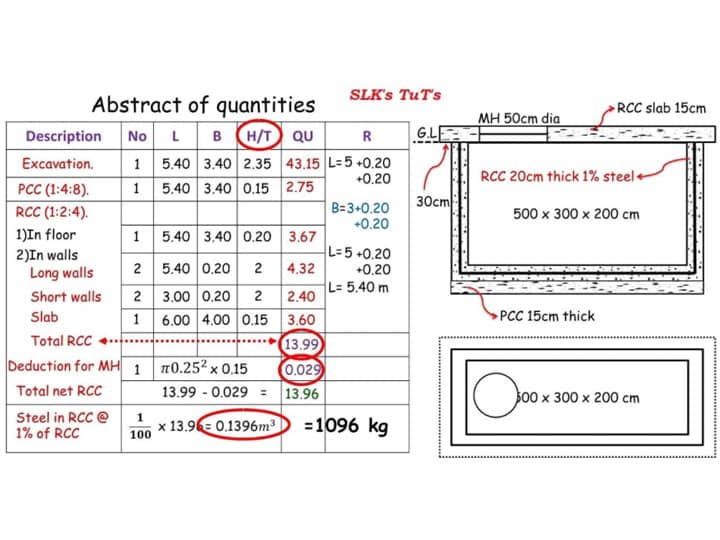Material Estimate of an RCC Underground Water Tank
Dating back to the early days of civilization, water storage facilities have been a part of the construction industry forever. Today there are many smaller pre-built water tanks available in the market, but more often than not we have to custom-build our water storages. To build one of them, you have to know about the amount of construction materials it needs. Today, we will give you a sample materials estimation of an RCC underground water tank.
Depending upon the usage and scenario, there can be many types of water storage tanks. Especially in dry areas, you have to do some serious thinking about how exactly would you want to store your water. Because you need a consistent supply of water without getting it wasted or overdrawn.
Types of water tanks
Here are some common varieties of water storage tanks we can find:
Drinking water tank
These are either small portable tanks, or fixed large vertical tanks. Either are generally cylindrical in shape. Sometimes filtering equipment are fitted on the outlet of the tanks. They require regular maintenance and cleaning.
Fire suppression tank
Some builders employ a large tank (or a system of them) connected to the sprinkler system in the building. These tanks aren't generally used but kept full as backup.
Irrigation tank
Depending upon if you want to irrigate your field or water your plants, the irrigation tanks can be large or small. They don't require filtration systems and so much regular cleanup. These are connected to the irrigation channels via regulator or to the garden sprinklers or hose.
Waste water storage
These are generally large, underground vaults used to hold sewage. They may be connected to the drainage lines or may not.
Calculating Water Tank Installation Estimates
We have the following data:
- RCC water tank is circular.
- Plain cement concrete = 1:2:4 with thickness = 10 cm.
- RCC = 1:2:4 with thickness = 10 cm.
- Opening for water tank is 60 cm with thickness = 10 cm.
- Thickness of RCC walls = 15 cm.
- 1% of 4M bars is used in wall.
- Depth of wall = 3 meter.
- Diameter of center hole/circle = 4 m.
- Diameter of extra wall is 15 cm.
- Diameter of outer wall is 10 cm.
- Diameter, of center is the hole in section = 4.15 cm up to the wall
- Diameter of PCC = 4.5 cm.
Therefore, the calculations will go as per the following:
Diameter of PCC:
- = 4 + 0.15 * 2 + 0.10 * 2
- = 4.5 meter
PCC work:
- Π / 4 * (Diameter of PCC)2 * Thickness of PCC
- = Π / 4 * (4.5)2 * 0.1
- = 1.59 m3
RCC work for walls:
- Π / 4 * (D2)2 * Thickness
- = Π / 4 * 4.3 * 0.15
- = 2.178 m3
- Π / 4 * ((D2)2 - (D1)2) * Depth
- = Π / 4 *((4.3)2 - (4)2) * 3
- = 5.867 m3
RCC work for 10 cm slab (1:2:4):
- = Π / 4 * (D2)2 * Thickness
- = Π / 4 * (4.3)2 * 0.1
- = 1.452 m3
Deduction for hole:
- Π / 4 * (D3)2 * Thickness
- = Π / 4 * (0.60)2 * 0.1
- = 0.0282 m3
RCC work for slab after deduction:
- = 1.452 - 0.0282
- = 1.423 m3
Total RCC:
- (2.178 + 5.867 + 1.423) m3
- = 9.468 m3 * Steel
- = 1/100 * 9.468
- = 0.09468 m3
- = 0.09468 * 7850
- = 744 kg steel required
Total net RCC:
- = 9.468 - 0.09468
- = 9.373 m3
Total cement, sand, and crushed stone volume:
- = 9.373 + 1.59
- = 10.963 m3
Ratio:
- Cement: Sand: Aggregate
- Material = Ratio of material/Sum of ratio * Dry Volume
- Cement = C/C+S+CA * Dry Volume
- Sand = S/C+S+CA * Dry Volume
- Total concrete work = 10.963 m3
- Ratio = 1:2:4
- Sum of ratio = 7
- Dry Volume = Wet Volume * 1.54
- 10.963 * 1.54 = 16.883 m3
- Materials = Ratio of materials/sum of material * Dry Volume
- Cement = 1/7 * 16.883 = 2.41 m3
- We know, 1 bag of cement in m3 = 0.035
Therefore,
Cement bags required:
- = 2.41/0.035
- = 68.8 bags
- = 69 bags
Sand required
Aggregate required
Steel bar required:
- = 744 kg (as found above).
